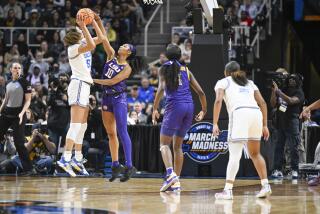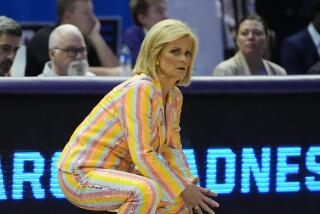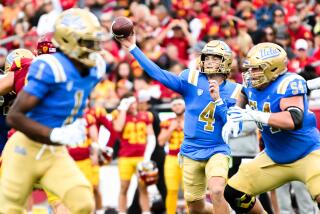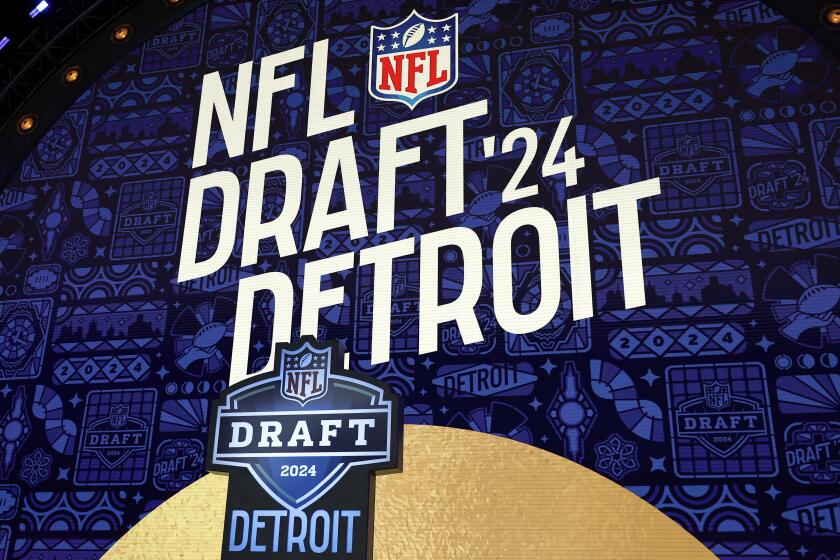College sports: Boola boola vs. moola moola
Thousands of college football fans had their pick of games Saturday — historic rivals Michigan and Michigan State and Oklahoma State and the University of Texas faced off in anticipated games, while top-ranked LSU took on the Tennessee Volunteers. On Sunday, the National Football League drew fans in similar legions, crowding stadiums in Detroit and Chicago, New England and Green Bay; millions more watched from couches across America.
Both days are sports extravaganzas, and lucrative ones. Millions are spent on advertising during telecasts of the games; logos cover the stadiums and team uniforms. The coaches and staffs play to win, and those who do stand to make millions of dollars a year.
But the money flows unevenly. Sunday’s games were played by millionaires — a top NFL player can make more than $10 million a year. Saturday’s were played by amateurs, whose efforts make their schools and sports leagues rich but who themselves are compensated only with scholarships.
That disparity has long been the subject of debate, and it has been re-energized in recent weeks by Taylor Branch’s powerful essay in this month’s Atlantic magazine. Titled “The Shame of College Sports,” it is a thorough indictment of the state of college athletics. Branch’s conclusions are sobering. “I once … shuddered instinctively at the notion of paid college athletes,” he acknowledges. “But after an inquiry that took me into locker rooms and ivory towers across the country, I have come to believe that sentiment blinds us to what’s before our eyes. Big-time college sports are fully commercialized. Billions of dollars flow through them each year. The NCAA makes money, and enables universities and corporations to make money, from the unpaid labor of young athletes.”
Branch’s essay has stoked a long-running conversation about how best to reconcile the competing impulses of college athletics. His descriptions of transparent injustices — athletes who lose their ability to play over trivial NCAA rules violations, the lack of insurance coverage for student athletes, scholarships voided for athletes who are hurt or lose their touch, legal waivers that allow the NCAA to control the likenesses of college stars long after they have graduated — have touched a nerve among educators and sports officials. And though opinion is sharply divided over Branch’s proposed remedy — paying the athletes — many officials acknowledge that a wholesale review of the NCAA’s rules is long overdue.
There are some basic reforms that would address problems discussed by Branch and acknowledged by college athletic directors and administrators:
• It is unfair to bring poor students to campuses to play ball and to waive their tuition but then to expect them to survive without money. For Branch, the remedy is to professionalize college sports altogether by offering the players a salary. That’s appealing, but it creates tensions of its own. Would football and basketball stars rake in millions while Olympic-caliber college athletes in water polo or track got nothing? Many coaches and athletic directors are advocating “cost of attendance” scholarships — stipends that would cover tuition, room and board and some reasonable payment for incidentals such as books, travel and spending money. Students who work in libraries or school newspapers as teaching assistants are allowed to earn modest sums of spending money. Why not athletes for their work? Cost-of-attendance scholarships would be a valuable innovation.
• Today’s student athletes lack the most basic worker protections. If a student working in a library is injured by a book falling on her head, she is covered by workers compensation or by college insurance. If a student is crippled on the playing field, she is not. The NCAA should extend insurance protection to athletes, treating sports as more akin to work-study, and offering death benefits to the families of those who perish in practice or during games. In addition to offering basic security for players, requiring the NCAA to insure them might also encourage development of safety measures.
• Scholarships should not be revocable. For too many students, education comes to an end when their eligibility expires or they are injured or cut from a team. Schools that lure athletes to their campuses with the promise of free education should be good to their word. Once accepted, a scholarship must be binding, whether the athlete completes that degree in four years or comes back to finish his education at some later point.
• The NCAA’s rights to an athlete’s likeness should end at graduation. Hard as it is to believe, college athletes today are required to permanently waive their rights to their own images as players as a condition of participating in college sports. That means that the NCAA continues to profit from images of Michael Jordan playing for the University of North Carolina or Jackie Robinson at UCLA. Athletes make their own careers; the NCAA should not be allowed to profit from those achievements forever.
Even if adopted in their entirety, these proposals would not cleanse college sports of their commercialism. At major campuses, sports are and would remain multimillion-dollar-a-year businesses, fervidly backed by alumni and awash in revenue from sponsorships and television contracts, as well as ticket sales and souvenirs. For some, the disparity between the wealth of those programs and the unpaid labor of their stars will remain intolerable and continue to fuel calls for paying athletes outright.
Lawsuits challenging aspects of that disparity already threaten to upend the NCAA’s current system — one is challenging the requirement that athletes give up the rights to their images, for instance, and another is taking on the notion that scholarships can be revoked if a player is injured or cut from a team. Recognizing that, the NCAA’s governing board would be wise to tackle reform before others take the matter into their own hands. These reforms offer an opportunity to eliminate some of the system’s more egregious inequities while preserving its essence as an amateur endeavor.
More to Read
Get our high school sports newsletter
Prep Rally is devoted to the SoCal high school sports experience, bringing you scores, stories and a behind-the-scenes look at what makes prep sports so popular.
You may occasionally receive promotional content from the Los Angeles Times.






